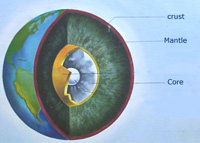Atlanteans may live in their underworld beneath our feet
The great Dmitry Mendeleev was a many-sided scientist. Aside from devising the famous periodic law and periodic table of chemical elements, he also came up with a theory of non-organic origins of petroleum. In fact, Mendeleev’s contemporaries failed to understand his theory. A generally accepted organic theory maintains that petroleum was formed from the remains of decayed vegetable matter. Indeed, complex chemical compounds that occur only in ferns and horsetails are found in petroleum. According to Mendeleev’s theory, petroleum is a product of reactions between the hydrides of metals and water at high temperatures and pressures in the depths of Earth. The formation of acetylene bubbles after a piece of calcium carbide is put into water is the simplest analogy.

More importantly, Mendeleev believed that the formation of petroleum had not stop millions years ago. An oil field has been recently discovered in Siberia. In terms of geology, the formation of the field took place just recently. The discovery effectively proved Mendeleev’s theory. Should the theory of our great compatriot is true, humankind would never run out of petroleum, and all the grim forecasts are not worth a plugged nickel. In other words, all of us would be living in clover till the end of time.
The radius of the planet Earth is about 6,400 km, it is longer than a distance between Moscow and Beijing. The Kola well is the deepest well man could drill on Earth. It is just 12 km deep, it is shorter than a distance between the Kremlin and the Chinese Embassy in Moscow. The depth of the well equals about 0.2 percent of the radius of Earth. However, scientists use indirect data for doing research on inner strata of Earth. Important conclusions regarding the composition of Earth as deep as 300 km can be made by studying magma that is spit out by volcanoes. Using data obtained by seismic prospecting (the speed of passing of seismic waves) scientists build a mock-up of “Pluto’s underworld.” At the moment the mock-up looks as follows: a solid metal core sits at the center of the planet; a liquid core made up of melted silicates; solid lower and upper mantles; and, finally, the earth’s crust on which we tread.
Stiff crust is otherwise known as lithosphere, while atmosphere is gaseous and hydrosphere (oceans and seas) are liquid. The lithosphere is composed of plates, which move about the mantle. Africa and America were something akin to unified whole in the days of old but later they drifted apart. The theory of the moving plates is now universally recognized. Earthquakes and volcanoes are continuously active in the border areas of the plates.
Still, there is not much information with regard to processes that happen right beneath our feet. Newtheoriesabout the existence of the underground worldareborn continuously due to lack of scientific knowledge. One theory says the underworld is populated by Atlanteans who opted for the underworld following many disappointments of living under the sun. Another theory maintains that the underworld is the place where the white-eyed monsters took shelter after being displaced by the Slavs from the Central Russian plateau.
In theory, scientists do not rule out the possibility of discovering large cavities in the upper strata of the mantle, those cavities could be big enough to hold a couple of hundred Atlanteans or white-eyed monsters. The cavities need to be discovered.
Ernst Muldashev, a well-known third-eyed explorer, put forward a theory about the existence of a mysterious country Shambala, which has rivers flowing with milk between the banks of fruit jelly. The country is particularly custom-made for the Enlightened Ones.
According to Muldachev, the following personalities fall under the category: Elena Blavatskaya, Nikolas Roerich, Buddha, and a few hundred Tibetan monks plus Muldashev himself, a temporary resident of the city of Ufa in the Republic of Bashkortostan. One can travel to Shambala by using numerous Tibetan caves on condition that a traveler reaches the state of somati beforehand. The state can be reached by those who can see the light following days of lengthy meditation and days without food, water, and carnal pleasures. Geologists have not yet found the traces of Shambala and the Enlightened Ones. Perhaps the mystery of the underworld will be unraveled in the future.
Extremely high temperatures in the depths of Earth are the main problem for deep drilling operations. Estimates indicate that the temperature should rise 1 degree every 33 m as a drill penetrates the rocks that make up the earth’s crust; thus, the temperature is expected to go up to 300 degrees Celsius at the depth of 10 km, it should reach about 500 degrees at 15 km. Drilling tools and equipment can not function at such high temperatures. Prior to drilling, scientists had to find a place where the bowels of the earth were a little cooler. Finally, scientists found a location on the Kola Peninsula, which rests on an ancient crystalline shield. A drilling rig was built on the northern tip of the peninsula. The drilling commenced in 1970; projected depth of a well was 15 km. 12,262 meters were drilled by June 1990. The drilling of the Kola well was put on hold in 1994. The drilling results were entered in the Guinness Book of Records three years later. These days the well is a laboratory for researching the deep bowels of Earth.
Izvestia Nauki
Translated by Guerman Grachev
Pravda.Ru
Discuss this article on Pravda.Ru English Forum
Subscribe to Pravda.Ru Telegram channel, Facebook, RSS!




